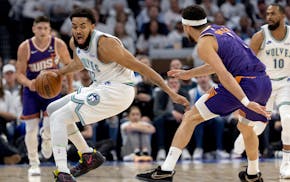Behold the baseball glove: Talisman and totem, tactile symbol and wearable nostalgia, proof of the human race's occasional bursts of genius.
There is nothing in the world like a baseball glove, nothing so dear and perpetually near. Take it from the 12-year-old me.
As a child, I read and saved every article on sports I could find, watched every game we could pull in with the antennae on our small, boxy television, and played every sport and sports board game available.
My bedroom walls were rumors hidden behind sports posters and pennants. Ticket stubs, baseball cards and sports books obscured the floor, along with footballs, basketballs real and Nerf, and baseballs.
It sounds silly to say that all of those things were my life, but that's the way it felt to a painfully skinny, socially awkward, sickly kid whose family moved every few years. All those primary colors and faded memories made the bedroom more museum than refuge.
Even then, if you had forced me to choose between a room filled with memorabilia, books, collectibles and other equipment, and my baseball glove, I would have taken the glove.
My first glove that didn't feel like melted plastic was a Rawlings Brooks Robinson infielder's model. I had to have Brooks' name on it. Living in southern Pennsylvania and then outside Baltimore, Robinson became the ideal idol for millions of us. He was a spectacular fielder, a clutch hitter, a winner, and a nice man willing to sign unlimited autographs.
If you lived near Baltimore and didn't have Brooks Robinson's autograph, you had turned him down.
Later in life, Baseball Hall of Fame President Jeff Idelson would tell me that the two nicest Hall of Famers he ever met were Harmon Killebrew and old Brooksie, two guys who looked like dads, acted like favorite uncles and played like gods.
I had done my homework. I took my new Rawlings, applied a thin layer of Neat's Foot Oil, placed a baseball in the palm and wrapped it in a belt, to create the ideal shape for capturing ground balls. Over time the leather molded to my hand like a second skin, and I learned how to extract the ball faster than John Wayne could draw his six-shooter.
Hours of banking baseballs off the front stairs and the nearby tennis backstops taught me how to think of the glove as an extension of myself.
I took it anywhere there might be a baseball — the playground, my friends' houses, Orioles games, walks through the woods. Brooksie, the glove, represented all that was good and desirable in my little-boy world.
I grew up, belatedly. Brooksie suddenly seemed small like a miniature version of its old self. When I started playing more outfield than infield, I needed a bigger glove. My father took me to the sporting goods store and the only outfield glove that fit right bore the name of Reggie Jackson, who was serving a one-year exile in Baltimore.
Even after the Neat's Foot Oil and the belt and the ball, Reggie didn't feel the same as Brooksie. It was a quality tool that performed its designed task, but there was no poetry in it, no perceived connection. I kept Brooksie and wore it when I could, even though the palm had worn so thin that a hard throw would bruise my hand.
The gloves had one thing in common. They were the way my father expressed affection at a time when few fathers, especially workaholic veterans, were willing to verbalize their feelings.
I passed both gloves on to my kids, who used them but only in the way you might use a potholder to remove a hot dish from the oven.
Now I'm 52. I haven't played catch in years. I don't seek or keep memorabilia. I am highly unsentimental. I dislike most forms of nostalgia. And I miss Brooksie — how that glove felt, and smelled, and what it meant.
Reggie Bush reinstated as 2005 Heisman Trophy winner. Changes in NCAA rules led to the decision
First-round picks could be on the trading block on day 1 of the NFL draft

KAT in early foul trouble, but came back big in second half

Another big Vikings need might not be addressed early in draft

